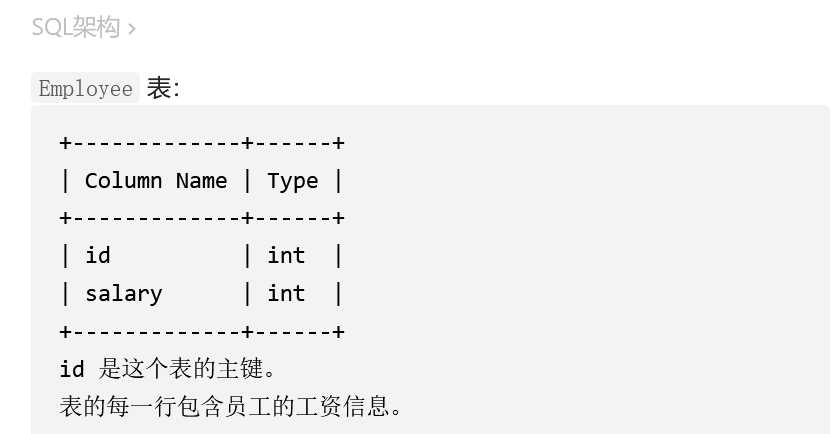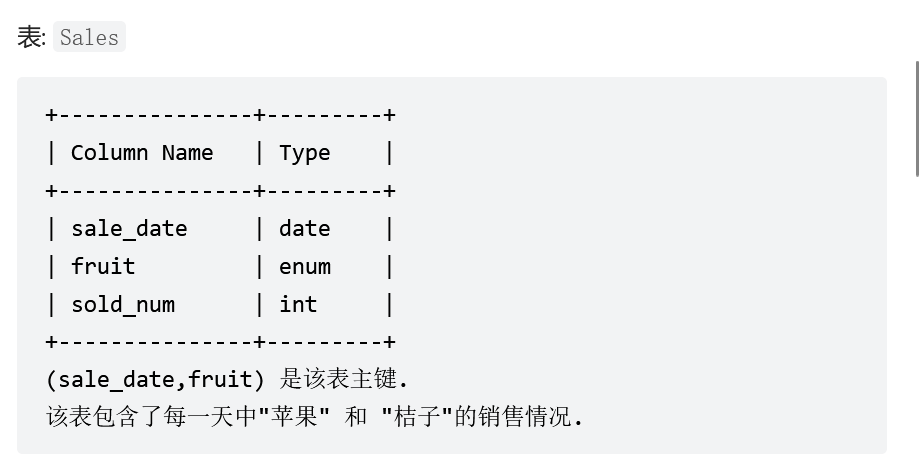目录
1 从不订购的客户


子查询方式
select name Customers
from Customers
where id not in (
select CustomerId from orders
)连接查询
select c.name as Customers
from Customers as c left join Orders as o on c.Id = o.CustomerId
where o.Id is null连接过程是这样的:Customers表左连接Orders表,所以Customers表是主表,将Customers表中的内容原封不动的抄下来
| c.Id(o.customerid) |
Name |
|---|---|
| 1 |
Joe |
| 2 |
Henry |
| 3 |
Sam |
| 4 |
Max |
因为连接条件是c.id=o.customerid,数据库会利用笛卡尔积在Orders表中进行选择,将满足条件的结果添加到上面,注意这里我们是通过c.id和o.customerid进行连接的,所以两个表中的相应列现在合成了上面的一列
| c.Id(o.customerid) |
Name |
o.Id |
|---|---|---|
| 1 |
Joe |
2 |
| 2 |
Henry |
|
| 3 |
Sam |
1 |
| 4 |
Max |
因为c.id=3和c.id=1在两个表中都有,所以其o.id对应的值添加在上面的表中,对于o.id没有的,数据库会直接赋值为Null,所以最终连接结果表为
| c.id(o.customerid) |
Name |
o.Id |
|---|---|---|
| 1 |
Joe |
2 |
| 2 |
Henry |
Null |
| 3 |
Sam |
1 |
| 4 |
Max |
Null |
我们就是在上面这个连接表中进行查询的,利用where o.Id is null将那些没有订单的客户找出来
2 计算特殊奖金


使用条件语句控制奖金列的计算方式
这里的约束条件一是员工的ID是奇数,可以用%2!=0表示,姓名不以M开头可以表示为not like 'M%'或者left(name,1)!='M',
第一种是使用MySQL中的if语句,if(条件,语句1,语句2)如果条件成立执行语句1,否则执行语句2
select employee_id,
if (employee_id%2!=0 and name not like 'M%',salary,0) as bonus
from employees
order by employee_id第二种是使用case when then else end语句
select employee_id,
case
when employee_id%2!=0 and name not like 'M%'
then salary
else 0
end as bonus
from employees
order by employee_id3 删除重复的电子邮箱


delete的另一种用法
DELETE p1
from person p1,person p2
where p1.email=p2.email and p1.id>p2.id4 修复表中的名字

常用的字符串处理函数
concat():字符串连接
left(s,n):获取字符串左边第n个字符
lower()、upper():字符串大小写转换
substring(s,n):从字符串s第n个位置开始截取
select user_id,concat(upper(left(name,1)),lower(substring(name,2))) as name
from users
order by user_id5 按日期分组销售产品


group_concat官方DOC

将一组非NULL结果以字符串连接的形式返回,如果有NULL值直接返回NULL,可指定连接元素的排列和分隔符,默认是升序和以‘,’分割
select sell_date,
count(distinct product) num_sold,
group_concat(distinct product) products
from activities
group by sell_date
order by sell_date7 丢失信息的雇员



两种解决方式
select temp.employee_id
from
(select a.employee_id
from employees a left join salaries b on a.employee_id=b.employee_id
where b.salary is NULL
union
select b.employee_id
from employees a right join salaries b on a.employee_id=b.employee_id
where a.name is NULL) as temp
order by temp.employee_idunion可以将两个结果表去重的合并在一起,那么先寻找姓名缺少再寻找工资缺失,然后通过union进行去重合并就能得到所有信息缺失的ID
select
employee_id
from
(
select employee_id from employees
union all
select employee_id from salaries
) as t
group by
employee_id
having
count(employee_id) = 1
order by
employee_id;
将两个表合并到一起,然后根据ID分组,分组中ID数量为1的表示有信息缺失
8 每个产品在不同商店的价格




宽表变长表
select product_id,'store1' as store,store1 as price
from products
where store1 is not NULL
union all
select product_id,'store2' as store,store2 as price
from products
where store2 is not NULL
union all
select product_id,'store3' as store,store3 as price
from products
where store3 is not NULL另外补充长表变宽表
select product_id
case when store='store1' then price else NULL end as 'store1',
case when store='store2' then price else NULL end as 'store2',
case when store='store3' then price else NULL end as 'store3'
from products
order by product_id9 第二高的薪水


逻辑法
第二就是小于第一的最大值
select if(max(distinct salary) is not NULL,max(distinct salary),NULL) as SecondHighestSalary
from Employee
where salary<(
select max(salary)
from Employee
)limit关键字
MySQL中imit y offset x 分句表示查询结果跳过 x 条数据,读取前 y 条数据。
select ifnull((
select distinct salary
from Employee
order by salary desc
limit 1 offset 1
),NULL) as SecondHighestSalary窗口函数
#外面select可以处理NULL值
select (
select salary
from
(
#利用窗口函数获取排名信息表
select salary,
#dense_rank当有并列排名时
#下一个排名是接着上一个的排名
#就像这样:1,1,2
dense_rank() over (order by salary desc) rn
from Employee
) as t
#获取第二高,只返回一个
where t.rn=2 limit 1
) SecondHighestSalary10 上升的温度



datediff(日期1,日期2)返回两个日期相差的天数
# Write your MySQL query statement below
select a.id
from weather as a
#当天温度比前一天高
where a.temperature>(
#获取前一天的温度
select b.temperature
from weather as b
where datediff(a.recorddate,b.recorddate)=1
)
order by a.id进行SQL优化,从笛卡尔积中取结果
SELECT b.Id
FROM Weather as a,Weather as b
WHERE a.Temperature < b.Temperature and DATEDIFF(a.RecordDate,b.RecordDate) = -1;11 股票的资本损益


多表构造连接方式
select a.stock_name,b.sell_money-a.buy_money as capital_gain_loss
from
(
##创建每只股票购买所花的钱数
select stock_name,sum(price) as buy_money
from stocks
where operation='Buy'
group by stock_name
) as a
inner join
(
##创建每只股票出售所获得的钱数
select stock_name,sum(price) as sell_money
from stocks
where operation='Sell'
group by stock_name
) as b on a.stock_name=b.stock_namecase语句
select stock_name,
sum(
case operation
when 'Buy' then -price
else price
end
) as capital_gain_loss
from stocks
group by stock_name12 销售分析



SELECT s.product_id, product_name
FROM Sales s
Left JOIN Product p
ON s.product_id = p.product_id
GROUP BY s.product_id
HAVING MIN(sale_date) >= '2019-01-01' AND MAX(sale_date) <= '2019-03-31'13 两人之间的通话次数


A给B打,B也给A打的话,将回拨电话记录列进行交换,只以打电话中的一个人为中心进行分组统计

least()函数用来寻找一些值中最小的一个 ,group by 除了可以指定列名还可以使用表达式
select from_id as person1,
to_id as person2,
count(from_id) as call_count,
sum(duration) as total_duration
from calls
group by least(from_id,to_id),greatest(from_id,to_id)14 苹果和桔子


聚合函数是用在整个分组上的,所以可以在其中控制分组中每一项的具体表达式
select sale_date,sum(
case fruit
when 'apples' then sold_num
else -sold_num
end
) as diff
from sales
group by sale_date
order by sale_date15 每月交易


带有条件的计数和求和,注意count中的or NULL条件
select
left(trans_date,7) as month,
country,
count(state) as trans_count,
count(state='approved' or NULL) as approved_count,
sum(amount) as trans_total_amount,
sum(if(state='approved',amount,0)) as approved_total_amount
from transactions
group by country,year(trans_date),month(trans_date)16 购买了产品A、B但是没有买C的客户



instr(A,B)可以在字符串A中搜索B如果包含B返回B首次出现的位置,否则返回0
# Write your MySQL query statement below
select customer_id,customer_name
from customers
where customer_id in (
#统计买了产品A、B但是没有买C的ID
select a.customer_id
from (
#统计每个用户的购买情况
select customer_id,group_concat(distinct product_name) as times
from orders
group by customer_id
) as a
#用instr进行筛选
where instr(a.times,'C')=0 and instr(a.times,'A')!=0 and instr(a.times,'B')!=0
)
order by customer_id17 学生们参加各科测试的次数




count(列名)时如果这个列所有的值都为NULL返回0,先交叉连接构建出学生和学科的对应关系然后左外连接考试信息表,进行分组,在每组进行统计
SELECT a.student_id, a.student_name, b.subject_name, COUNT(e.subject_name) AS attended_exams
FROM Students a CROSS JOIN Subjects b
LEFT JOIN Examinations e ON a.student_id = e.student_id AND b.subject_name = e.subject_name
GROUP BY a.student_id, b.subject_name
ORDER BY a.student_id, b.subject_name
18 换座位


直接改变ID
select
if(
id%2=0,
id-1,
if(id=(select count(distinct id) from seat),
id,
id+1))
as id,student
from seat
order by id
19 连续空余座位


利用join进行表和自身的笛卡尔积,然后筛选出连续的、都是空闲的座位
select distinct a.seat_id
from cinema a join cinema b on
#连续的座位
abs(a.seat_id-b.seat_id)=1 and
#都是空闲的
a.free=1 and b.free=1
order by a.seat_id20 应该被禁止的用户


SELECT DISTINCT a.account_id AS account_id
#隐式自连接
FROM LogInfo a, LogInfo b
WHERE
#某个用户
a.account_id = b.account_id
#异地登录
AND a.ip_address != b.ip_address
#一个还没下线
AND a.logout <= b.logout
#另外一个就进行了登录
AND b.login <= a.logout
21 每所学校最低录取分数



连接中可以使用不等条件
select
school_id,
#取最低分数,如果为null,则输出-1
ifnull(min(score), -1) as score
from
Schools s left join Exam e
#容量需大于分数段学生数量
on capacity >= student_count
group by school_id22 餐馆营业额变化增长


滑动窗口可以控制窗口的大小
当前行 - current row
之前的行 - preceding
之后的行 - following
无界限 - unbounded
表示从前面的起点 - unbounded preceding
表示到后面的终点 - unbounded following
取当前行和前五行:ROWS between 5 preceding and current row --共6行
取当前行和后五行:ROWS between current row and 5 following --共6行
取前五行和后五行:ROWS between 5 preceding and 5 folowing --共11行
elect
visited_on,
amount,
average_amount
from (
select
visited_on,
#按照访问日期进行排序
row_number() over(order by visited_on) as rk,
#过去7天用rows指定
#最外一层的sum是组内求和
sum(sum(amount)) over(order by visited_on rows between 6 preceding and current row) as amount,
round(avg(sum(amount)) over(order by visited_on rows between 6 preceding and current row), 2) as average_amount
from Customer
group by visited_on
) as base
where rk >= 7
order by visited_on